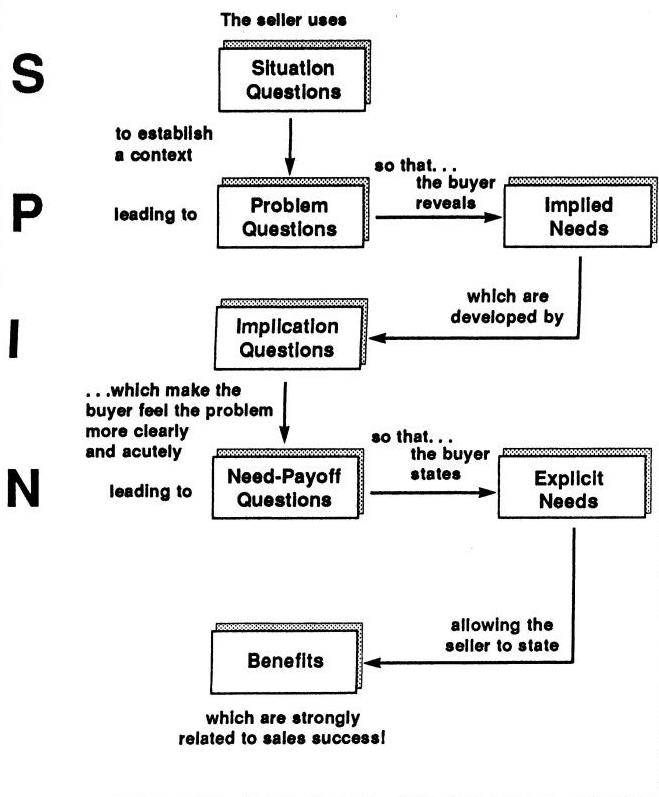Neil Rackham is an English sales and marketing researcher, developer of SPIN selling techniques, and consultant to many well-known corporations. The SPIN selling method is developed based on a long-term study by Huthwaite, the founder of which is Neil Rackham.
The essence of the research was aimed at comparing the principles by which expensive and inexpensive goods are sold. According to the results of the study, it was found that the techniques that successfully work in the small sales do not always work for the major sales, and sometimes even interfere with them.
The major sales have several features from psychology point of view:
1 – Length of selling cycle. A large deal may require several meetings and many months of cooperation.
2 – Size of customer’s commitment. The large purchases require the buyer to make a serious decision.
3 – The ongoing relationship. The large sales involve a long-term relationship with the buyer.
4 – The risk of mistakes. Big decisions are always public, and bad big decisions are especially obvious to others. The more serious the decision, the more cautious the buyer is.
Neil Rackham identifies the four stages of a sales call.

Preliminaries. The warming-up events at the start of the call. At this stage, an impression is formed that may affect the course of negotiations in the future. It is necessary to pay attention to your manner of introducing yourself and how you start a conversation.
Investigating. Finding out facts, information, and needs. At this stage, you collect data about customers, their business, and their needs. You can use questions to get information about the client.
Demonstrating capability. At this stage, you need to convince the customer that you have something to offer them. You show that you have a solution to the problems of the client. You demonstrate the product and describe its advantages.
Obtaining commitment. At this stage, we are talking about a set of steps leading to the conclusion of a deal. In small sales, it involves the conclusion of a sales contract or transaction. In large sales, it may involve other obligations before receiving the order.
All these stages are important for successful calls, but Neil Rackham highlights the investigating stage. The questions make the customer talk, control their attention, reveal their needs, and convince consumers more than any explanation.
It is considered that questions are divided into two types — open questions and closed questions. You can answer closed questions — “Yes” or “No”. Open questions require a detailed answer. Open questions allow you to get more information, but they do not guarantee the success of the meeting.
The purpose of the questions should be to discover and disclose the buyer’s needs. Needs are divided into two types: implied and explicit.
Implied needs are the buyer’s presentation of problems, difficulties, and discontents. Explicit needs are specific statements made by the buyer about the need or desire for a purchase.
The author introduces a new classification of questions based on his research:
1. Situation questions. These questions provide general information. These questions request information about a specific customer’s situation. Here it is necessary to remember that too often asked situation questions can cause boredom in the client. For example: What sort of business do you run? What equipment are you using at present?
2. Problem questions. These questions explore existing disadvantages and difficulties. The experienced sellers ask more problem questions. However, in the area of large sales, they also do not have much impact on the effectiveness of meetings. For example: Are you satisfied with…? Do you have quality problems?
3. Implication questions. These questions increase the importance of the problem. They are aimed at making implied needs become larger. For example: What effect does that have on output? Could that lead to increased costs?
4. Need-payoff questions. These questions focus on the desirability or value of a solution. They reduce the number of objections and encourage the buyer to focus on solutions. For example: How would that help? What benefits do you see? Why is it important to solve this problem?
So, these four types of questions form a scheme of work called SPIN. SPIN is an abbreviation of the words: situation, problem, implication, need-payoff. The SPIN selling model focuses on sales performance. The sequence of questions in it is focused directly on the psychological aspect of the purchase process.
The author advises asking questions depending on the situation, not necessarily asking questions in this order. If the customer starts the meeting by telling them about their obvious need, then you can immediately go to the questions that guide them.

The author gives the four golden rules for learning skills in mastering SPIN selling.
- Practice only one behavior at a time. Don’t go to the next step until you’ve mastered the first one.
- Try the new behavior at least three times. Most likely, the application of the new method in practice will be accompanied at first by failures and awkwardness.
- Quantity before quality. It is better to sell a lot than to try to sell well without success.
- Practice in safe situations. New skills almost always cause embarrassment and inconvenience. So don’t use really important meetings to train your skills.
Neil Rackham also provides some simple and sensible tips to help you improve your sales performance immediately.
1. Focus on the investigating stage. Think not about what to tell the customer, but about what to ask them.
2. Develop questions in the SPIN sequence. Don’t try to practice implication and need-payoff questions right away. First, start asking more situation questions. At the next stage, go to the problem ones, and only then work out the implication.
3. Analyze your product in problem-solving terms. (but not characteristics or advantages) Analyze product by listing the problem they are designed to solve.
4. Plan, Do, and Review. After each meeting, ask yourself the following questions:
- Did I achieve my goals?
- If I were making the call again, what would I do differently?
- What have I learned that will influence future calls on this account?
- What have I learned that I can use elsewhere?
The main idea of the SPIN selling method is to establish trusting relationships with clients by asking the right questions and building a call process.
A useful book for both beginner and experienced sellers. This book is effective for acquiring new knowledge and skills, and for understanding existing behaviors and sales techniques.
Find more interesting marketing and sales book reviews in the Book Reviews section of my website.





